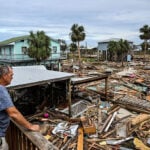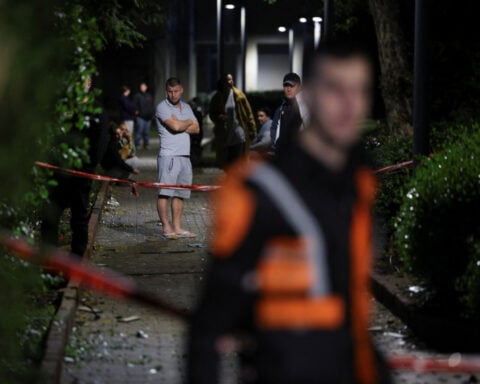Beirut, Lebanon (CNN) — When Israel struck the center of Beirut in the early hours of Thursday, it seemed to wipe out what little sense of safety remained in the Lebanese capital.
For nearly a week, Israel has been bombarding Hezbollah-dominated residential neighborhoods in the southern suburbs of Beirut. But this strike in a Shia quarter near the parliament building – a part of the city that has been spared since the 2006 war with Israel – signaled that the scope of Israel’s campaign may be quickly expanding.
Windows across the skyline lit up just as the crash and boom of the missile roused people from sleep. A dark plume of smoke rose from the heart of the capital — people frantically called their loved ones as they tried to work out where Israel’s bombs had hit this time.
The strike had bombed an office belonging to the Islamic Health Authority, affiliated with Hezbollah, in the central Bashura neighborhood, killing nine people including seven medics, according to the health ministry and the Islamic Health Authority itself.
On the street impacted by the strike, people wandered in a daze. Women cradled babies in their arms, as they weaved through the carnage. Unlike the southern suburbs and other parts of the country, there was no warning to evacuate this Shia-majority neighborhood.
Down the road is the Mohammad al-Amin mosque, a colossal landmark in the city, now an emblem for the constant state of movement of the roughly 1 million people displaced by Israel’s air offensive in Lebanon which began last Monday.
Families fleeing the central Beirut strike on Thursday streamed into the mosque’s grounds. Just as they arrived, many of those who had already been camped out there were packing up their belongings to flee again.
The newly displaced were replacing those already made homeless, who were now seeking safer grounds north of the city.
“The whole mosque shook. People ran away thinking they were going to be bombed,” said a middle-aged women named Fatima. She sat on a folded up cardboard box, leaning against a column. “And just as they fled, others came.”
“If I weren’t so sick, I would have left too. But I don’t have the energy to be displaced again.”
The Mostafa family from the southern Beirut suburbs share three mattresses amongst themselves amid the mosque’s looming colonnades. “I can’t afford to leave this place,” said Mostafa Mostafa. “Isn’t it such a shame, what’s happened? We were a proud Lebanese family with a roof over our heads. Our home gave us dignity. Now look at the state of us.”
Fears of mission creep
Israel’s offensive in Lebanon has killed over 1,300 people since it began on September 17, according to a CNN tally of Lebanon’s health ministry statements. Israel’s war cabinet said it aimed to repatriate 60,000 people displaced by Hezbollah’s rocket fire in the country’s northern-most territory. Hezbollah for its part said it would only agree to a ceasefire on the Israel-Lebanon border when the Israeli offensive in Gaza ends.
Israel says that its strikes have targeted Hezbollah’s weapons depots, command and control structures and its general infrastructure. But many of those killed are believed to be civilians, according to the health ministry which does not distinguish between combatants and civilians. An air warfare expert told CNN that the ferocity of the campaign in Lebanon already matches that of Gaza, where a ground, air and naval offensive levelled large parts of the besieged strip.
The war here may have just arrived at yet another dangerous juncture. Israel has amassed its troops on the border and begun its ground war. It has rained down artillery and drone strikes on the area, forcing people to flee as the Israeli military seek to pave the way for an invasion of the south of the country and establish a establish a buffer zone.
Yet they have been met with a fierce defense from Hezbollah fighters whose mountainous native terrain poses challenges to an invading force. According to multiple reports, Israeli forces have breached the armistice line between Lebanon and Israel several times in the last two days, conducting raids and enduring fatalities, and then withdrawing
Meanwhile Israel’s targeting of Hezbollah’s civilian arms, such as the health authority on Thursday morning and its media center later in the afternoon, widened the scope of its stated goals to destroy the Iran-backed group’s command and control as well as its arsenal.
It has raised the specter of mission creep, thrusting the country, no stranger to conflict and crises, into uncharted waters.
“We are now literally paralyzed. We cannot do anything,” said Mahdi, an alumnus of the American University of Beirut, a five minute drive from the site of the attack on the Islamic Health Authority.
Mahdi had fled his home in the southern Beirut suburbs to west Beirut and was taking a job around his old campus. “We have a blank idea about our futures,” he added.
“They’re getting scarier because it feels like by the day, things are escalating, and we don’t really know what area is safe anymore,” said Hadeel, a medical student at the university, established by American missionaries nearly 200 years ago.
“Will it keep on going? Will the West speak out, or are we just another country in the Middle East?”
The-CNN-Wire
™ & © 2024 Cable News Network, Inc., a Warner Bros. Discovery Company. All rights reserved.

 Blake Lively accuses 'It Ends With Us' director Justin Baldoni of harassment and smear campaign
Blake Lively accuses 'It Ends With Us' director Justin Baldoni of harassment and smear campaign
 History looms in NCAA volleyball championship with female coaches poised as first to win a title
History looms in NCAA volleyball championship with female coaches poised as first to win a title
 Albania bans TikTok for a year after killing of teenager
Albania bans TikTok for a year after killing of teenager
 Suffering from heavy cold, Pope Francis to lead Sunday prayers from residence
Suffering from heavy cold, Pope Francis to lead Sunday prayers from residence
 Chinese ship linked to Baltic Sea cable breach resumes voyage
Chinese ship linked to Baltic Sea cable breach resumes voyage
 How Democrats kept leverage by averting a government shutdown, according to analyst
How Democrats kept leverage by averting a government shutdown, according to analyst
 Smerconish shares his take on the debt ceiling debate
Smerconish shares his take on the debt ceiling debate
 A pilot raced through the airport to surprise an old friend: the woman who saved his life
A pilot raced through the airport to surprise an old friend: the woman who saved his life








